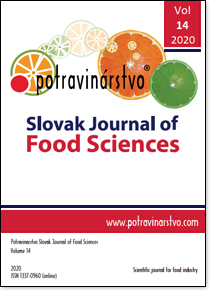Authentication of Wistar rat fats with gas chromatography mass spectometry combined by chemometrics
DOI:
https://doi.org/10.5219/1229Keywords:
chemometrics, food, GCMS, halal, PCA, Wistar rat fatAbstract
Indonesia is a country with the largest Muslim population in the world, which is very concerned about halal food. The most problem that’s very concerning nowadays was that food products were contaminated by unclean meat, such as rat meat. The purpose of this study was to authenticate rat fat using Gas Chromatography-Mass Spectrophotometry (GC-MS) combined with chemometrics. In this study, rat fat were heated in oven at 90 °C – 100 °C for approximately one hour until the oil came out. After that, the derivatization process was carried out to convert fat into methyl ester compounds using NaOCH3 and BF3. Methyl ester compound than injected into the GCMS instrument system. In addition to rat fat, other fat extraction were carried out, such as pigs, cows, chickens, wild boars, dogs, and goats. The combination of chemometrics Principal Component Analysis (PCA) was used to classify rat fat with other animal fat. Based on the results of the study showed that fatty acids in rats using GCMS produced 6 types of fatty acids, namely: myristat (0.15 ±0.09%), palmitoleate (0.73 ±0.54%), palmitate (19.08 ±3.54%), linoleate (30.14 ±16.90%), oleate (40.48 ±2.74%), and stearate (2.55 ±0.01%). Total content of rat fatty acids was 93.13%, with unsaturated fatty acids 71.35% and saturated fatty acids 21.78%. Chemometrics PCA from rat fat can be grouped with other animal fats.
Downloads
Metrics
References
Coltro, W. K. T., Ferreira, M. M. C., Macedo, F. A. F., Oliveira, C. C., Visentainer, J. V., Souza, N. E., Matsushita, M. 2005. Correlation of Animal Diet and Fatty Acid Content in Young Goat Meat by Gas Chromatography and Chemometrics. Meat Science, vol. 71, no. 2, p. 358-363. https://doi.org/10.1016/j.meatsci.2005.04.016 DOI: https://doi.org/10.1016/j.meatsci.2005.04.016
Guntarti, A. 2018. Authentication of dog fat with gas chromatography-mass spectroscopy combined with chemometrics. Intl. J. Chem., vol. 10, no. 4, p. 124-129 https://doi.org/10.5539/ijc.v10n4p124 DOI: https://doi.org/10.5539/ijc.v10n4p124
Guntarti, A., Amidin, M. A. Z. 2018. Dog fat analysis in chicken meatbun using FTIR (Fourier transform infrared) with chemometric combination. Media Farmasi, vol. 15, no. 1, p. 38-42. https://doi.org/10.12928/mf.v15i1.12356 DOI: https://doi.org/10.12928/mf.v15i1.12356
Guntarti, A., Prativi, S. R. 2017. Application method of fourier transform infrared (FTIR) combined with chemometrics for analysis of rat meat (Rattus diardi) in meatballs beef. Pharmaciana, vol. 7, no. 2, p. 133-140. https://doi.org/10.12928/pharmaciana.v7i2.4247 DOI: https://doi.org/10.12928/pharmaciana.v7i2.4247
Hermanto, S., Muawanah, A., Harahap, R. 2008. Profil dan Karakteristik Lemak Hewani (Ayam, Sapi dan Babi) Hasil Analisa FTIR dan GCMS (Profile and Characteristics of Animal Fat (Chicken, Cow and Pork) FTIR and GCMS Analysis Results). Valensi, vol, 1, no. 3, p. 102-109. https://doi.org/10.15408/jkv.v1i3.219 (In Indonesian) DOI: https://doi.org/10.15408/jkv.v1i3.219
Kumar, A., Lindley, M. R., Mastana, S. S. 2014. A time efficient adaptation of GC-FID method for analysis of PBMC lipid composition. Journal of Biochemistry Technology, vol. 5, no. 3, p. 760-764.
Lobb, K., Chow, C. K. 2007. Fatty Acid Classification and Nomenclature. In Chow, C. K. Fatty Acid in Foods and Their Health Implications. 3rd Edition, Florida, USA : CRC Press, 1296 p. ISBN 9780849372612. https://doi.org/10.1201/9781420006902.ch1 DOI: https://doi.org/10.1201/9781420006902.ch1
Lumakso, F. A., Riyanto, S., Ahmad, S. A. S., Rosman, A. S., Yusoff, F. M., Rohman, A. 2015. Application of chemometrics in combination with Fourier Transform Mid Infrared spectroscopy for authentication of avocado oil. J. Food Pharm., vol. 3, no. 1, p. 12-17. https://doi.org/10.14499/jfps
Miller, J. N., Miller, J. C. 2010. Statistics and Chemometrics for Analytical Chemistry. 6th ed. Harlow, England : Pearson Education Limited, 296 p. ISBN 0130309907.
Muslim, A., Purwanto, A. 2013. Pengaruh efisiensi keuangan dan pembatasan Pemberian dana pada jumlah donasi individual (Effect of financial efficiency and limitation giving funds on the amount of individual donations). Diponegoro Journal of Accounting, vol 2, no. 3, p. 1-11. (In Indonesian)
Purbasari, A. Silviana, S. 2008. Kajian Awal Pembuatan Biodiesel dari Minyak Dedak Padi dengan Proses Esterifikasi (Preliminary study of making biodiesel from rice bran oil with esterification process). Reaktor, vol 12, no. 1, p. 19-21. https://doi.org/10.14710/reaktor.12.1.19-21 DOI: https://doi.org/10.14710/reaktor.12.1.19-21
Rohman, A., Himawati, A., Triyana, K., Sismindari, Fatimah, S. 2016. Identification of pork in beef meatballs using fourier Transform Infrared Spectrophotometry and real- time polymerase chain reaction. International journal of food properties, vol. 20, no. 3, p. 1-20. https://doi.org/10.1080/10942912.2016.1174940 DOI: https://doi.org/10.1080/10942912.2016.1174940
Rohman, A., Che Man, Y. B. 2011. The Use of Fourier Transform Mid Infrared (FT-MIR) Spectroscopy For Detection and Quantification of Adulteration in Virgin Coconut Oil. Food Chemistry, vol. 129, no. 2, p. 583-588. https://doi.org/10.1016/j.foodchem.2011.04.070 DOI: https://doi.org/10.1016/j.foodchem.2011.04.070
Rohman, A., Man, Y. B. C. 2012. The chemometrics approach applied to FTIR spectral data for the analysis of rice bran oil in extra virgin olive oil. Chemometrics and Intelligent Laboratory Systems. Chemometric and Intelligent Laboratory Systems, vol 110, no. 1, p. 129-134. https://doi.org/10.1016/j.chemolab.2011.10.010 DOI: https://doi.org/10.1016/j.chemolab.2011.10.010
Rohman, A., Triyana, K., Sismindari, Erwanto, Y. 2012. Differentiation of lard and other animal fats based on triacylglycerols composition and principal component analysis. International Food Research Journal, vol. 19, no. 2, p. 475-479.
Ronggo, Y., Chalus, P., Maurer, L., Lema-Martinez, C., Edmond, A., Jent, N. 2007. A Review of Near Infrared spectroscopy and Chemometrics in Pharmaceutical Technologies. Journal of Pharmaceutical and Biomedical Analysis, vol. 44, no. 3, p. 683-700. https://doi.org/10.1016/j.jpba.2007.03.023 DOI: https://doi.org/10.1016/j.jpba.2007.03.023
Sari, T. N. I., Guntarti, A. 2018. Wild Boar Fat Analysis in Beef Sausage Using FTIRMethod (Fourier Transform Infrared) Combined with Chemometrics. Indonesian Journal Medicine and Health, vol. 9, no. 1, p. 16-23. https://doi.org/10.20885/JKKI.Vol9.Iss1.art4 DOI: https://doi.org/10.20885/JKKI.Vol9.Iss1.art4
Published
How to Cite
Issue
Section
License
This license permits non-commercial re-use, distribution, and reproduction in any medium, provided the original work is properly cited, and is not altered, transformed, or built upon in any way.






























